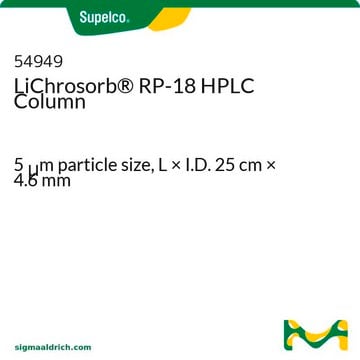1.50432
LiChrosorb® RP-8 (5 µm) HPLC Columns
L x I.D. 125 mm x 4 mm, Hibar® RT HPLC Column
Sinónimos:
TM=["LiChrosorb"] C8 HPLC column
About This Item
Productos recomendados
product name
LiChrosorb® RP-8 (5 µm) Hibar® RT 125-4, suitable for HPLC
material
stainless steel column
Quality Level
agency
suitable for USP L7
product line
LiChrosorb®
feature
endcapped: no
parameter
400 bar pressure
60 °C max. temp.
technique(s)
HPLC: suitable
mass spectrometry (MS): suitable (Low)
column L × I.D.
12.5 cm × 4 mm
matrix
fully porous particle
matrix active group
C8 bonding phase
particle size
5 μm
pore size
100 Å pore size
operating pH range
2-7.5
separation technique
reversed phase
supercritical fluid (SFC)
storage temp.
no temp limit
General description
Application
- Determination of amphotericin B, liposomal amphotericin B, and amphotericin B colloidal dispersion in plasma by high-performance liquid chromatography.: This study by Egger et al. focuses on the HPLC determination of various forms of amphotericin B in plasma, utilizing LiChrosorb® RP-8 as the stationary phase. This method ensures accurate monitoring of these antifungal agents in clinical settings (Egger et al., 2001).
- Determination of peptide hydrophobicity parameters by reversed-phase high-performance liquid chromatography.: This research by Rothemund et al. used LiChrosorb® RP-8 to determine the hydrophobicity of various peptides, providing valuable insights for peptide characterization in biochemical research (Rothemund et al., 1994).
- HPLC determination of doxorubicin, doxorubicinol and four aglycone metabolites in plasma of AIDS patients.: Beijnen et al. employed LiChrosorb® RP-8 in an HPLC method to quantify doxorubicin and its metabolites in plasma, offering a robust tool for therapeutic drug monitoring in AIDS patients (Beijnen et al., 1991).
Analysis Note
Theoretical Plates (N/m) (Toluene): ≥ 55000
Symmetry (Toluene): 0.8 - 1.4
Capacity factor (Toluene): 0.5 - 1.5
Legal Information
Certificados de análisis (COA)
Busque Certificados de análisis (COA) introduciendo el número de lote del producto. Los números de lote se encuentran en la etiqueta del producto después de las palabras «Lot» o «Batch»
¿Ya tiene este producto?
Encuentre la documentación para los productos que ha comprado recientemente en la Biblioteca de documentos.
Nuestro equipo de científicos tiene experiencia en todas las áreas de investigación: Ciencias de la vida, Ciencia de los materiales, Síntesis química, Cromatografía, Analítica y muchas otras.
Póngase en contacto con el Servicio técnico




